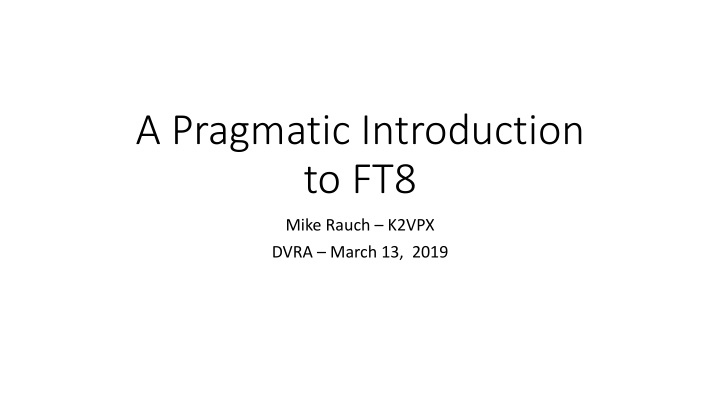



A Pragmatic Introduction to FT8 Mike Rauch – K2VPX DVRA – March 13, 2019
Agenda • Objective • FT8 Background • What is digital communications? • Why has FT8 become so popular? • A FT8 QSO • A little technical nitty gritty • Operating • What is needed to get on FT8 • Almost effortless FT8 • Recent FT8 features • Q&A
“People's reaction to FT8 the first time they see it is very dramatic. They either love it or hate it. If they love it, they will always love it. If they don't, they may learn to appreciate it, but it will never become part of their soul.” From the movie Pretty YL
Objective • Provide a basic understanding of FT8 operation and technology. • No evangelism.
Fast Fourier Transformation (FFT)
FT8 background • One of several protocols included in WSJT-X software. • Originally written by Joe Taylor K1JT, is now open source, and development is done by a small team lead by Joe. • Protocols for weak signal communications (WS) • EME, propagation studies, meteor scatter
What is digital communications? • Binary representation of data (zeroes and ones) • Simple to Complex Modulation • Frequency shift • Amplitude • Phase • Narrow bandwidth • Error Correction
Bit Per Second versus Baud per Second The bit rate is the number of bits transmitted per second, whereas, the baud rate is the number of signal units transmitted per second and one signal unit is able to represent one or more bits . Therefore, baud rate is always less than or equal to the bit rate but never greater.
Why has FT8 become so popular? • Faster than prior modes (JT9) • Weak signal QSOs • Low transmit power • Compromised antennas • It’s different • Relatively easy to get going with guidance…. • Another mode to set self goals (DXCC, WAC, WAS etc.)
FT8 QSO • Ham radio SMS • Fixed format • Exchange of calls, grid square, and signal reports • Automated process • Automatic resending
FT8 QSO Remote Local CQ W2ZQ FN20 W2ZQ K2VPX FN20 K2VPX W2ZQ -1 W2ZQ K2VPX R-8 K2VPX W2ZQ RR73 W2ZQ K2VPX 73
A little technical nitty gritty • 15 Second timeslots (Synchronized/Accurate clock necessary) • FSK-8 modulation / audio tones • 5.86 Hz tone spacing • 6.25 baud • 50 Hz bandwidth • 12.6 Seconds Tx • 77 bit message (Payload) • Forward error detection/correction • Domain encoding (message format, call signs)
A little technical nitty gritty - 2 • During reception, sampling from audio card is copied to disk • At end of Tx time of timeslot data is decoded using Fast Fourier Transform (FFT) to extract multiple signals • Decoded message can then be subtract from sample data allowing for decoding of additional signals. Multiple stations on same ”frequency”
Frequency Shift keying (FSK) • Information is transferred by changing of frequency • RTTY(FSK-2) – Mark/Space – Zero/One- 850 Hz shift (2125 / 1275) • FT8 (FSK-8) One baud is three bits 100 101 110 111 011 000 001 010
How can everyone use the same frequency? • Signal mixing – Sum and difference of signals • 1KZ -> 14.074 = 14.073(LSB) + 14.074(Carrier) + 14.074(USB) • Suppress LSB and carrier (Single Sideband) • FSK Modulate around USB frequency (50hz bandwidth)
Software • WSJT-X • https://physics.princeton.edu/pulsar/k1jt/wsjtx.html • FT8, JT4, JT9, JT65, QRA64, ISCAT, MSK144, and WSPR • Free
Hello… Can anyone hear me? • CQ CQ CQ……………Silence………. • Has this ever happened to you?
PSK Reporter • Check box on WSJT-X • Participating stations send received call signs with signal report to PSK Reporter server. • You can go to PSK Report website and see who has heard you
What is needed to get on FT8 • SSB rig • Antenna • Computer • Sound card (internal or external) • WSJT-X Software
Equipment block diagram Audio Card A/D – D/A Computer Transceiver Computer to Rig Control (Optional – Audio sweet spot) Windows, Mac OS, Linux • • PC, Raspberry PI, SBC Windows, Mac OS, Linux • PC, Raspberry PI, SBC •
K2VPX FT-8 Setup • IC 7300 - USB audio and rig control (CI-V) – 30Watts • Latte Panda SBC with Windows 10 Pro ($150 + $4) • Attic Dipole for 20 meters • Microsoft Remote Desktop Access • ~ 40 DXCC counties and WAC • ~700 contracts
Almost Effortless FT8 • Input to WSJT-X Through PC microphone • Output to rig via PC speaker • Web based SDR sites in lieu of receiver
Recent FT8 features • Fox and Hound for DX • Contest Formats • JS8Call Alternative Software
Operational Hints • Syncing PC clock • Digital curtain • Split frequency operation • More power is not always the answer • Turn off AGC • Watch Tx and Rx levels • Turn on split mode in WSJT-X software • Use widest Rx filter • Watch out for RF!
Pros and Cons … Pros Cons Good for weak signals e.g. marginal paths, QRP, Mechanized, without the personal touch that • • stealth antennas, poor conditions comes from legacy-mode human-to-human Efficient use of bandwidth: signals are just 50 Hz contacts and conversation • wide, and can often be decoded if they overlap Slow communication speed equivalent to about 5 • with others wpm Minimal QSO information is passed reliably Can seem complex and confusing for beginners • • FT8 DX Expeditions Problems with non-standard calls including CEPT • • Popular, with lots of HF activity travelers and special event calls • Popular, with lots of HF activity • Some grumpyold amateurs don’t believe FT8 is • real ham radio
Q&A
Recommend
More recommend